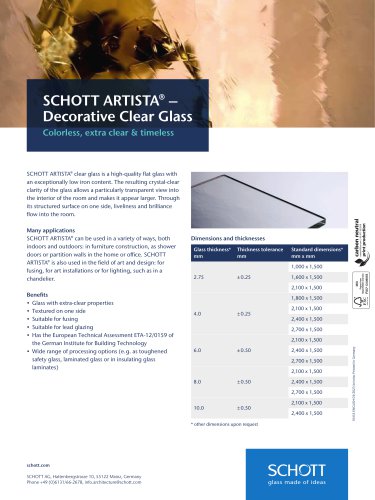
Catalog excerpts

GOETHEGLAS RESTOVER® TIKANA® Glass for Restoration
Open the catalog to page 1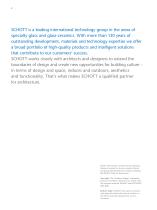
SCHOTT is a leading international technology group in the areas of specialty glass and glass-ceramics. With more than 130 years of o utstanding development, materials and technology expertise we offer a broad portfolio of high-quality products and intelligent solutions that contribute to our customers’ success. SCHOTT works closely with architects and designers to extend the boundaries of design and create new opportunities for building culture – in terms of design and space, indoors and outdoors, aesthetics and functionality. That’s what makes SCHOTT a qualified partner for architecture....
Open the catalog to page 2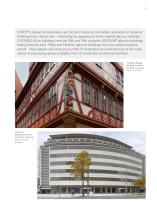
SCHOTT’s Glasses for Restoration are the best choice for the faithful restoration of historical buildings from various eras – mimicking the appearance of the original glazing materials – GOETHEGLAS for buildings from the 18th and 19th centuries, RESTOVER® glass for buildings dating from the early 1900s and TIKANA® glass for buildings from the classical modern period – these glasses also meet any number of contemporary needs because of the wide variety of processing options available, from UV protection to thermal insulation. “Goldene Waage” building, Frankfurt am Main, Germany Photo: ©...
Open the catalog to page 3
Accurate in style and true to the times Historical in form, innovative in function Restoring historical monuments is a delicate task in which every aesthetic nuance is important. SCHOTT’s Glasses for Restoration provide the wide range of materials that architects need to do the job right. Manufactured using the traditional Fourcault process, the look of the glass is based on historical window glasses from different eras. Production process The traditional Fourcault process vertically draws glass from a liquid melt upwards through a nozzle and into a drawing shaft. At the end of the shaft,...
Open the catalog to page 4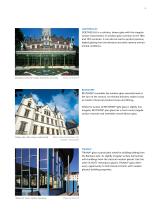
GOETHEGLAS GOETHEGLAS is a colorless, drawn glass with the irregular surface characteristic of window glass common to the 18th and 19th centuries. It can also be used to protect precious, leaded glazing from the elements and other adverse environmental conditions. Orangery Schwerin Castle, Schwerin, Germany RESTOVER® RESTOVER® resembles the window glass manufactured at the turn of the century. Its minimal thickness makes it easy to install in historical window frames and fittings. While the surface of RESTOVER® light glass is slightly less irregular, RESTOVER® plus glass has a much more...
Open the catalog to page 5
Bauhaus-University Weimar – The Brendel Studio using SCHOTT RESTOVER® laminated glass. SCHOTT Glass for Restoration For monument authenticity in step with the times SCHOTT enhances restoration glazing by integrating proven modern solutions, such as heat insu lation-, sun- and UV-protection, secure overhead mounting, burglar resistance, soundprotection, which were unknown at the time of original construction. Elements of these solutions include coatings and films, inert gas fillings between the window panes and a number of different spacers for insulating glass units, colored or otherwise....
Open the catalog to page 6
SCHOTT AG Hattenbergstrasse 10 55122 Mainz Germany Phone +49 (0)6131/66-2678 info.architecture@schott.com www.schott.com/restoration CAT_0051_OM ENGLISH 02/2019 kn/odd Printed in Germany
Open the catalog to page 8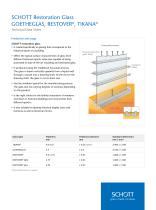
SCHOTT Restoration Glass GOETHEGLAS, RESTOVER®, TIKANA® Technical Data Sheet Production and usage SCHOTT restoration glass • Is created specifically as glazing that corresponds to the historical epoch of a building. • Offers the typical surface characteristics of glass from different historical epochs while also capable of being processed as state-of-the-art insulating and laminated glass. Fourcault process Drawing direction glass sheet Transport rollers • Is produced using the traditional Fourcault process. The glass is drawn vertically upwards from a liquid melt through a nozzle into a...
Open the catalog to page 10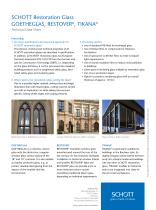
SCHOTT Restoration Glass GOETHEGLAS, RESTOVER®, TIKANA® Technical Data Sheet 2. hat needs to be considered when cutting the glass? W to a possibly higher residual cooling stress and larger Due distortions than with floated glass, cutting must be carried out with an expansion cut while taking into account specific cutting wheel angles and cutting pressures. 3. Processing options • Use of standard PVB films for laminated glass • Use of thicker films to compensate for thickness fluctuations • Use of special UV or IR filter films to meet increased light requirements • Use of sound insulation...
Open the catalog to page 11All SCHOTT AG catalogs and technical brochures
-
ARTISTA®
1 Pages
-
NOVOLAY® secure PYRANOVA® secure
12 Pages
-
Glass-ceramic for fireplaces
36 Pages
-
Radiation Shielding Glass
12 Pages
-
RIVULETTA®
2 Pages
-
SCHOTT Ampoules
24 Pages
-
Fire Resistant Glass
14 Pages
-
PYRAN® Star
2 Pages
-
Radiation shielding glass
8 Pages
-
Bauhaus University Weimar
4 Pages
-
A Day with SCHOTT
17 Pages


